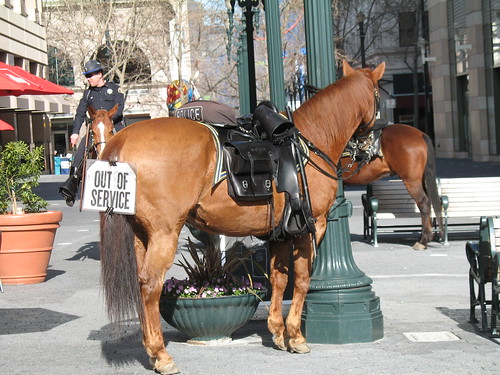You’ve probably heard the story of how cars saved cities from the problem of crushing piles of horse manure. The usual telling rings true to modern ears: 19th century cities depended absolutely on horses for the transport of people and goods, so much so that great stinking mounds of manure polluted streets and our air. Luckily for western civilization, the automobile came along just in time to solve our problems.

Economists like to tell this tale as an example of how technological innovation unhindered by government regulation and taxation always comes to the rescue when we encounter a seemingly intractable crisis.
The problem: This economist’s urban myth is so much horse excrement.
Writer Brandon Keim shovels the poop to uncover the facts of history in Nautilus. I’ve touched before on the history of roads as a public commons before motoring interest groups redefined roads as exclusive domains of motor vehicles.
The late 19th and early 20th centuries was the age of streetcars. Running on steel rails, a few pulled by horses but most powered by electricity, they were the dominant urban mode of vehicular transport. The first suburbs date to this time, rising along streetcar lines in Boston, Los Angeles, Pittsburgh, and other cities. The “streetcar suburbs” featured single-family houses branching off store-lined main streets, the very model of walkable, humane villages now celebrated by urban planners and citizens. Only a handful of wealthy drivers actually thought of cars as personal transportation, and that mostly involved weekend countryside jaunts.
To the average city dweller, the idea of a city oriented around transportation in cars, and especially privately owned cars carrying one or a few people, would have been incomprehensible. Indeed, the modern idea of a street as an artery, existing primarily to convey vehicles, would have been foreign. Streets were more like parks, used by streetcars, horses, cars, and pedestrians, but also as playgrounds and gathering places.
Keim doesn’t mention bikes, but we’ve seen that even cyclists were seen as dangerously fast interlopers in those heady days of the scorcher menace. The then-powerful League of American Wheelmen responded to these criticisms by timidly asking their members to play nicely and shaming those who didn’t abide by the rules.
The young American Automobile Association, on the other hand, worked to completely overhaul society with their disruptive social agenda. This brainwashing is so unbelievably complete today that we have bike advocates who blame scofflaw cyclists for the public relations problem we sometimes have, completely missing the irony that the reason stop signs and red traffic lights even exist is because of automotive traffic.
The more nuanced short history by Keim is worth a read. Via Tom Vanderbilt.
Did you catch Klein’s paragraph on autonomous vehicles?
“Looking ahead, the current unsustainability of our automobile love won’t emerge from technological engineering, but social engineering, too. Historians Wells and Norton both view driverless cars, currently the darling of Silicon Valley, as a cosmetic upgrade on the status quo, promoted as revolutionary, but likely changing little. In a real revolution, they say, driverless cars would be one of many transportation options, along with bicycles, buses, and rail, in greener, saner, non-auto-centric future cities.”
Well maybe…but are you going to call this article horses***? I don’t think so. http://www.uctc.net/access/30/Access%2030%20-%2002%20-%20Horse%20Power.pdf